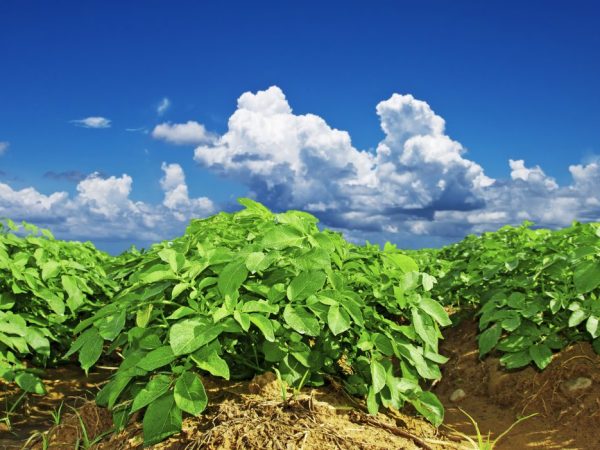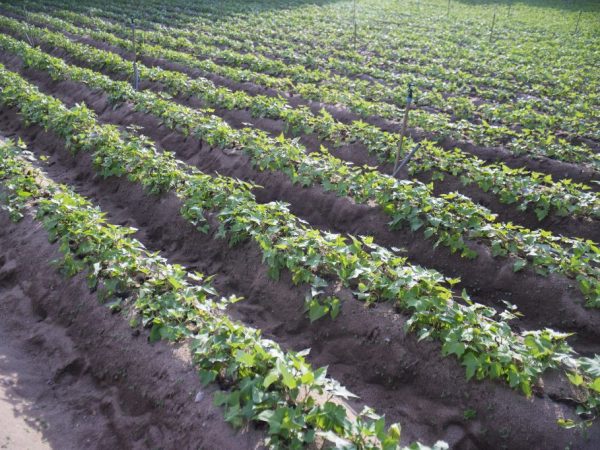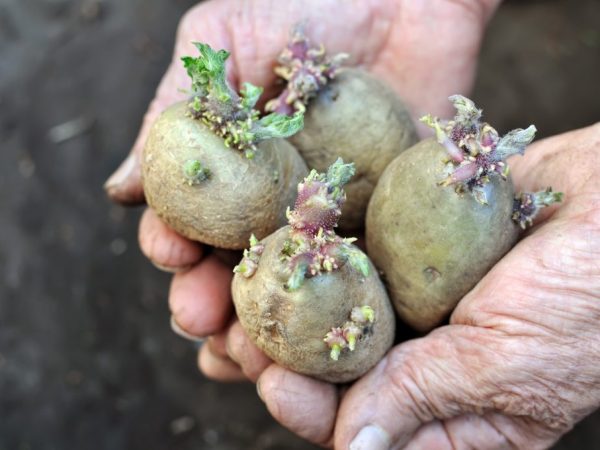The principle of Dutch potato cultivation technology
There are very few arable lands in Holland that are not very fertile. Despite this, today the Dutch potato growing technology is used throughout Europe. This technology implies the use of high-quality seed material, as well as tight control at all stages of growth. The technique can be used both for obtaining large volumes of nightshade on industrial grounds, and in the country.

The principle of Dutch potato cultivation technology
The essence of the method
Growing potatoes using Dutch technology is distinguished by the ridge planting method. This move allows you to clearly control the oxygen supply and soil moisture level. Recommended planting depth is maximum 10 cm.
The cultivation scheme involves planting in shallow trenches. As the ground part develops, the earthen roll is increased, which makes it possible to enrich the soil with oxygen, avoid stagnant moisture and the spread of fungal diseases. Growing potatoes according to Dutch technology requires strict adherence to agrotechnical rules at every stage of crop development. The method involves the implementation of such activities:
- selection of high-quality seed material;
- preparatory work with the soil;
- planting plants according to a certain scheme;
- proper care;
- harvesting potatoes.
The scheme of growing potatoes according to the Dutch technology was developed by specialists for use on an industrial scale. However, many farmers use the method at home. Compliance with agrotechnical rules throughout the growing season can significantly improve the quality of the soil and get a good harvest. Growing technology allows you to get 2-3 kg of potatoes from 1 bush.
Planting material
Which potatoes are suitable for Dutch cultivation? First of all, you need to choose a good potato variety. Even varieties that are not prone to degeneration are recommended to be completely renewed after 4-5 years. A root crop loved by many, it is very often exposed to various fungal diseases, therefore, over the years, the yield in any case begins to decline. In recent years, Dutch varieties have been particularly popular. However, some farmers prefer domestic varieties of potatoes, citing the mediocre taste of Dutch crops. In addition, imported plants do not take root in every region.
Among the Dutch varieties, the most commonly used are:
- Impala;
- Jarl;
- Eba;
- Frisia;
- Prior and others.
Popular domestic varieties: Luck, Nevsky, Sonok, Lugovskoy.
Seed preparation
Potatoes of the first reproduction should not be taken as seed, it is better to give preference to 2-3 reproductions. Potatoes 3-5 cm are ideal for Dutch cultivation. Smaller roots should not be used.Each potato must have at least 5 eyes.
Dutch technology potatoes should be germinated first. To do this, use any of the standard methods used for a normal landing. The difference is that the Dutch plant the potatoes when the sprouts reach 0.5 cm. These sprout sizes are optimal for mechanical planting. In our regions, seedlings with such sprouts can die from a sharp temperature drop, so do not rush to planting. Sprouts on potatoes should reach at least 2.5 cm, especially if planting is carried out manually in a summer cottage.
Working with soil

It is important to choose the right landing site
Planting potatoes using Dutch technology involves additional preparatory work with the soil. An important condition is the choice of the site. It is not recommended to plant potatoes on slopes. In this case, the water will flow down, and the earth will fall off.
The method involves the use of a fertile layer for sprinkling potatoes. It must contain humus, otherwise you need to generously fertilize the soil with organic matter. It is strictly forbidden to disembark at the same place. The culture can be returned to the old site only for 3 years. In the conditions of small areas, the culture is grown in the same place, with the condition of introducing a large amount of organic matter and treating the soil with herbicides.
You should not plant potatoes in place of tomatoes or other nightshade crops. This can lead to late blight infection. It is recommended to select the site where the following grew:
- winter crops;
- beans;
- linen;
- radish;
- cereals;
- cucumbers;
- legumes.
Autumn preparation
The process of soil cultivation begins in the fall, after the harvest. The site is dug to a depth of 25-30 cm, removing all roots and weeds. After that, organic fertilizer is applied, at the rate of 5 kg per 10 m2.
Of mineral fertilizers, they are practiced using potassium compounds and superphosphates, in amounts of 0.2 kg and 0.5 kg. If the site is slightly inclined, it is better not to carry out autumn feeding, otherwise in the spring it will wash the nutrients with water. Before planting potatoes, you need to choose a way to control weeds and pests. For this, the Dutch use large quantities of mineral fertilizers and herbicides. In a small farm, it is advisable to use only minerals.
Spring preparation
In the spring, the site should again be loosened to a depth of about 15 cm. This method allows you to maintain the optimal amount of oxygen in the deep layers of the soil. With this cultivation method, air chambers are formed through which moisture circulates.
If in Holland the planting is carried out without waiting for the soil to warm up, then in our conditions you need to wait until the soil is ready for planting. It is not recommended to tamp or cover the ground. This will allow the upper layers to dry out and heat up faster. In the spring, most often, nitrogen-potassium compounds are introduced, for example, ash or urea.
Optimal disembarkation time

Potatoes can be planted in mid-March
The main requirement for the planting date is the preparedness of the soil. When the ground is well behind the shovel, you can start planting the tubers. Potatoes start to be planted around mid-March. The term will differ depending on the climatic conditions of the region. It is not recommended to plant in unheated soil, otherwise the tubers may freeze out.
With an early planting, the root system develops much faster, and the ground part grows evenly. It is important to remember that preparation of the ground begins just before planting. If you prepare for a month, the aeration and drainage process is disrupted, which reduces the yield indicators.
Disembarkation scheme
In conditions of large farms and small private lands, planting is carried out from north to south.Thanks to this method, the plants are evenly illuminated from all sides, the risk of infection with a fungal disease is reduced. The optimal distance between the trenches is 75 cm. The indentations for planting should be 4-8 cm, maximum 10 cm.
Potatoes in the beds are placed in increments of 30 cm. With this arrangement, each bush has the ability to develop normally, and the rhizome receives the required amount of heat and minerals. In order to protect the plantings from wireworm and other pests, the bottom of the beds is sprinkled with onion husks, then fertilized with compost. The tubers themselves are powdered with ash.
To close the trenches, embankments are made 10 cm high and no more than 35 cm wide. Throughout the entire growth period, it will be necessary to periodically add soil. 28-30 days after the first shoots are hatched, the embankment is increased to 25 cm in height and 75 cm in width.
The culture needs regular loosening of the soil and adding soil to the crumbling ridges. In addition, the Dutch cultivation method involves the use of fungicides and herbicides in order to prevent the invasion of pests and the spread of fungal diseases. Performing simple plant care activities allows you to get a good harvest in any region.
Care
Care rules:
- after 14 days from the moment of planting, you need to remove the weeds, loosen the soil between the rows;
- to prevent the growth of weeds, the aisles should be treated with a herbicidal agent;
- watering is carried out 3 times for the entire season: during the budding period, after the flowers have fallen and a month before harvesting.
Regular loosening of the soil contributes to the uniform development of the ground part and rhizomes, as well as the removal of excess moisture. When using herbicides, it is important to take into account that the effect of the drugs lasts 14 days, therefore, 6 treatments are carried out for the entire period. Prevention with chemicals is carried out strictly before the beginning of budding. It is strictly forbidden to use chemicals during flowering.
When potatoes are grown using the Dutch method, direct irrigation is not used, otherwise the embankments can be destroyed. The best option is a drip system. It ensures uniform penetration of moisture into all soil layers. This watering option saves water and directs it directly to the rhizome.
Harvest
The harvest time depends entirely on the potato variety and the growing purpose. Seed potatoes of late varieties are harvested in early August. During this period, the bulk of root crops reaches the required size and degree of maturity. Otherwise, the dates vary from early July to late August.
Before harvesting, it is recommended to treat the tops with drying agents or mow them. As a result of this treatment, the tubers fully ripen, and the skin becomes dense. This allows you to reduce the risk of mechanical damage, as well as increase safety. Treatment with desiccants (drying agents) saves tubers from late blight infection.
All these drugs have a fungicidal effect, which is aimed at destroying the living tissue on which the spores of the fungus are located. As a result, the disease is destroyed along with the ground part and does not pass to root crops. Today, Dutch technology potatoes are often grown at home. This allows you to get a good harvest in any region.


